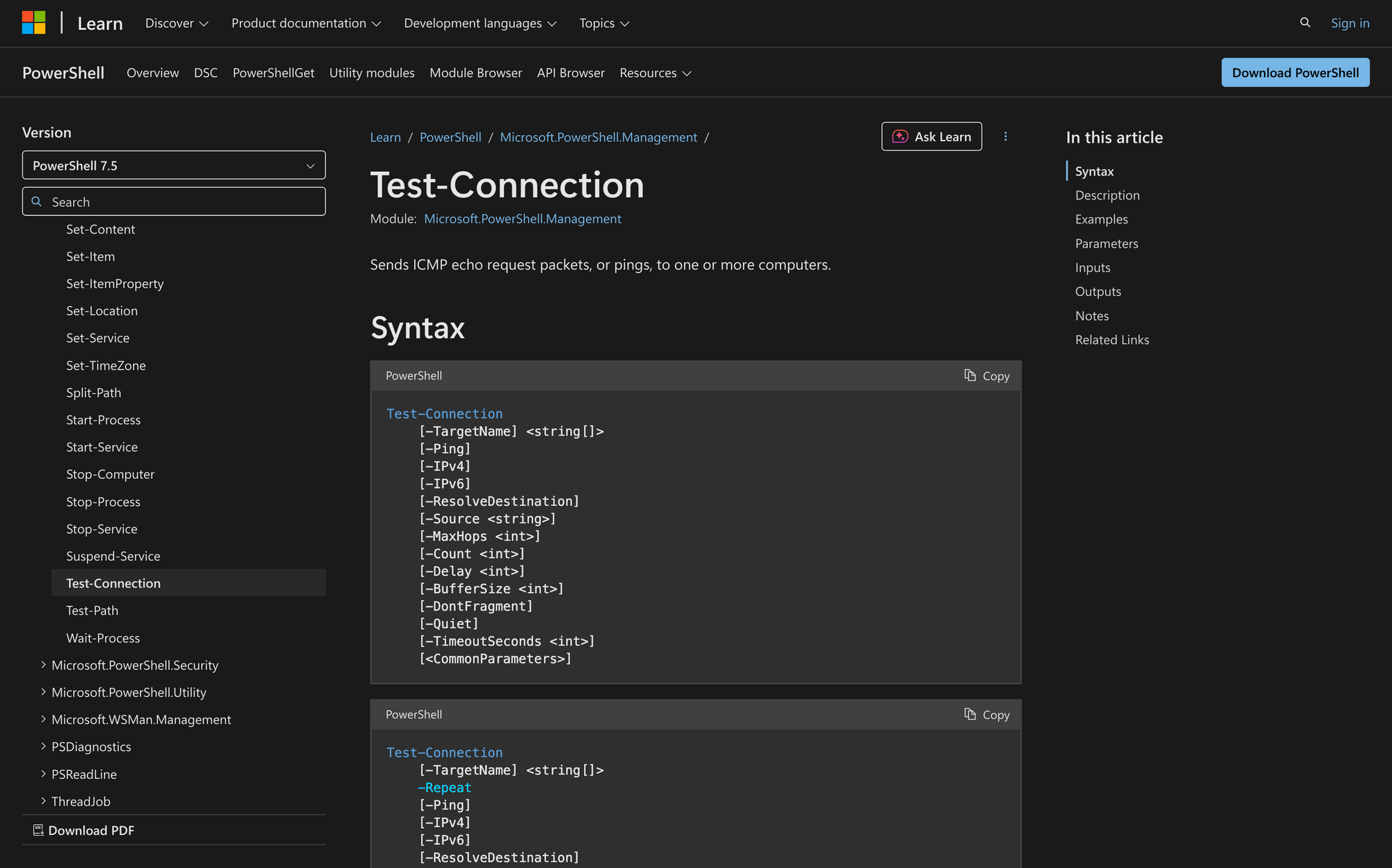Using Test-Connection in Powershell: All You Need To Know

If you've ever used the familiar ping command at the command prompt, you'll feel right at home with Test-Connection in PowerShell. This cmdlet is a more powerful, script-friendly version designed to test network connectivity, measure latency, and handle both simple and advanced diagnostics.
Unlike basic ping, Test-Connection is more versatile and works well with pipelines, background jobs, and custom output handling. Whether you're testing a single host or automating checks across hundreds of remote computers, this cmdlet gives you full control.
For more advanced network diagnostics, including port testing and detailed traceroutes, consider using PowerShell's Test-NetConnection cmdlet.
What is the Test-Connection Cmdlet?
Test-Connection is a built-in PowerShell cmdlet that sends ICMP echo request packets to specified targets, typically remote computers, and returns their ping response details.
It is part of the Microsoft.PowerShell.Management module and supports both local and remote testing, making it ideal for quick diagnostics or embedding into broader automation scripts.
This cmdlet works similarly to traditional ping but integrates more cleanly into PowerShell workflows. You can control the number of pings, interval, timeout, and source computers, or even run it as a background job to avoid blocking other tasks.
Syntax
Test-Connection
[-TargetName] <string[]>
[-Ping]
[-IPv4]
[-IPv6]
[-ResolveDestination]
[-Source <string>]
[-MaxHops <int>]
[-Count <int>]
[-Delay <int>]
[-BufferSize <int>]
[-DontFragment]
[-Quiet]
[-TimeoutSeconds <int>]
[<CommonParameters>]
Parameters
- ComputerName: Specifies one or more remote computers or IP addresses to test.
- Source: The computer or computers from which the test is initiated.
- -Quiet: Returns a Boolean response - only True or False based on success.
- -Count: Defines the number of echo request packets to send.
- -BufferSize: Controls the packet size in bytes.
- -Delay: Sets the interval between ping requests in seconds.
- -TimeToLive: Sets the TTL value for each ICMP packet.
- -Detailed: Returns a more verbose response with additional diagnostics.
- -AsJob: Runs the command as a background job, which can be retrieved with Receive-Job.
- -TimeoutSeconds: Specifies how long to wait for a response from each target.
- IPv4 / IPv6: Forces the command to use one IP version.
- CommonParameters: Includes standard PowerShell parameters like -Verbose, -ErrorAction, etc.
Key Differences: Test-Connection vs. Test-NetConnection
While both cmdlets deal with network testing, they are not interchangeable. Here’s a quick comparison to clarify their roles:
Should You Use Test-Connection or Test-NetConnection?
Use Test-Connection when you need a PowerShell-native ping with support for background jobs, output streaming, and batch testing.
Use Test-NetConnection for port-level testing, traceroutes, or specific connection debugging.
Practical Uses of the Test-Connection Cmdlet
Here are three real-world situations where the Test-Connection cmdlet is commonly used by system administrators or network engineers:
1. Verifying network connectivity between multiple computers in a domain
When rolling out software updates, verifying connectivity from the source server to all target computers ensures that installations will reach their destination. This avoids delays due to non-existent or offline computers.
2. Measuring latency and packet loss across a high-traffic network condition
In environments like call centers or trading floors, latency of connections and packet loss directly affect business operations. Test-Connection helps monitor response times, missed ICMP echo request packets, and ping response quality to proactively handle network bottlenecks.
3. Monitoring uptime of remote servers or network endpoints
For infrastructure that requires high availability - like external DNS servers or remote network share locations - Test-Connection can be scripted to run on a schedule and write results to logs, providing a baseline of network connectivity over time.
Prerequisites
Before using the Test-Connection cmdlet, ensure the following:
- PowerShell 7.5 or later is installed (for the most up-to-date syntax and behavior)
- Access to remote computers via ICMP is not blocked by a firewall
- Required permissions to send ICMP echo request packets from the source computer
- In environments requiring elevated privileges, administrative access might be necessary
How to Use Test-Connection: 10 Examples
Below are practical step-by-step examples of how to use the Test-Connection command effectively.
Example 1: Basic Ping Equivalent
Test-Connection -ComputerName "8.8.8.8"
This command sends 4 ICMP echo requests (pings) to the IP address 8.8.8.8 (Google DNS). It returns detailed information for each ping, including Address, ResponseTime (latency in ms), TimeToLive (TTL), and BufferSize. It’s the PowerShell equivalent of the traditional ping but outputs objects you can further manipulate. Use this to verify if a remote host is reachable at the network level. The command reports partial results if some pings fail, allowing you to spot intermittent connectivity.
Example 2: Ping with Custom Count
Test-Connection -ComputerName "google.com" -Count 10
By default, Test-Connection sends 4 pings. Using -Count 10 increases this to 10 echo requests, which provides a larger data sample. This helps detect intermittent packet loss or fluctuations in latency that a few pings might miss. The command outputs detailed round-trip times for each ping, enabling you to analyze network stability or jitter. Use this for more reliable diagnostics of network health, especially when troubleshooting inconsistent issues.
Example 3: Quiet Mode to Return Boolean
Test-Connection -ComputerName "192.168.1.1" -Quiet
Adding the -Quiet parameter causes the command to return only a True or False Boolean, indicating if any ping reply was received. It suppresses all verbose output. This is valuable in scripts where you want to quickly check reachability without parsing full ping details. For example, use it in conditional statements to decide on further actions based on host availability. Note that if ICMP is blocked by firewalls, this will return False even if the host is otherwise accessible.
Example 4: Specify Delay Between Pings
Test-Connection -ComputerName "server1" -Count 5 -Delay 2
This command sends 5 pings with a 2-second interval between each, controlled by the -Delay parameter. Slowing down the requests prevents flooding network devices and helps identify issues that only appear over time, such as intermittent drops or latency spikes. The detailed output per ping lets you observe individual response times and packet loss patterns. Without -Delay, pings are sent in quick succession, which may not expose transient network faults.
Example 5: Use Traceroute with TargetName Parameter
Heads up: This example requires PowerShell 6.0 or later (i.e., PowerShell Core or PowerShell 7+). It will not work in Windows PowerShell 5.1.
Test-Connection -TargetName "webserver.domain.com" -Traceroute
In PowerShell 6.0 and above, the Test-Connection cmdlet includes a -Traceroute parameter. When used with -TargetName, it performs a traceroute-style operation - showing each network hop to the destination, along with response time, IP address, and hop number - similar to the tracert command in Windows.
Note: The -Traceroute parameter works only with -TargetName, which accepts a string or list of hostnames/IPs. It does not work with the older -ComputerName parameter, which is not part of the cross-platform implementation.
Example 6: Set Time To Live (TTL)
Test-Connection -ComputerName "remotehost" -TimeToLive 128
The -TimeToLive parameter limits the number of hops the ping packet can take before being discarded. Setting TTL to 128 allows the packet to traverse up to 128 routers. If the TTL is too low, the packet expires before reaching the destination, useful for diagnosing routing loops or network path length. Monitoring the TTL value in replies helps detect firewalls or devices that modify packet TTLs, which can be important for troubleshooting connectivity and security policies.
Example 7: Use Source IP Address (for Multi-Homed Systems)
Test-Connection -ComputerName "8.8.8.8" -Source "192.168.0.10"
If your system has multiple network interfaces, -Source forces the ping to originate from the specified local IP. This lets you verify connectivity from a particular network segment or adapter, critical in complex or segmented networks with multiple routes. For example, test if your VPN or a secondary NIC can reach the destination. If you specify an IP not assigned to your machine, the command will fail immediately.
Example 8: Ping Multiple Hosts in One Command
Test-Connection -ComputerName "host1", "host2", "host3"
This sends pings to multiple hosts sequentially and groups the results by hostname. It’s a quick way to check reachability of several devices in a single command without scripting explicit loops. Each group includes latency and TTL details per ping. Use this when managing many servers or devices, helping identify which hosts respond normally and which don’t. Results can be piped or exported for monitoring and reporting.
Example 9: Running Test-Connection Asynchronous Job
Start-Job -ScriptBlock { Test-Connection -ComputerName "10.0.0.1" -Count 20 }
Running Test-Connection as a background job prevents blocking the PowerShell prompt during long tests. You can continue working or run other commands while the pings execute. Retrieve results later with Receive-Job -Id <jobId>and check status with Get-Job. This approach scales for parallelizing network tests or long-duration monitoring. Remember to clean up jobs with Remove-Job after completion to free system resources.
Example 10: Batch Ping Hosts from a File
Get-Content hosts.txt | ForEach-Object { Test-Connection -ComputerName $_ -Quiet }
This reads each line of hosts.txt as a hostname or IP, then runs a quiet ping on each. The -Quiet flag returns a Boolean per host for quick success/failure detection. Since Test-Connection doesn’t accept pipeline input for -ComputerName, you need ForEach-Object to iterate. This method is ideal for automated network audits, where you check dozens or hundreds of hosts regularly and trigger alerts or logs based on the results.
Test-Connection is a reliable built-in PowerShell tool for network reachability checks. Use its parameters to tailor packet counts, delays, and output formats to your needs.

